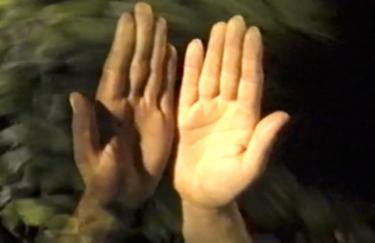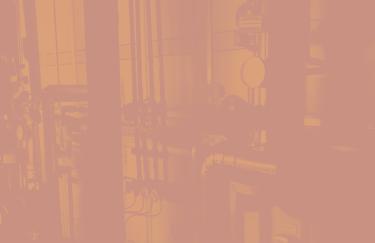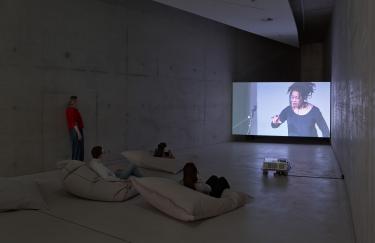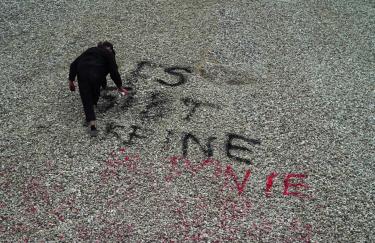![ELA EIS, Miracle Whip [Befreit], 1979 ELA EIS, Miracle Whip [Befreit], 1979](/sites/default/files/styles/custom_fallback/public/media/images/2022-05/ELA%20EIS__Miracle%20Whip_Befreit_1.jpg?itok=X4ahezhF)
LES DÜSSELDORFS
LES DÜSSELDORFS brings together video works by artists who work or have worked in Düsseldorf. The program reflects the rich and lively history of Düsseldorf video art, which was shaped by Nam June Paik, Nan Hoover and Marcel Odenbach, among others. In addition, there are activist, musical, sub- and countercultural positions that have written history from and about Düsseldorf with the medium of video.
A long-lost feminist performance, an artistic statement against the Cold War, critical reflections on urban development and a contemplation on isolation during the Corona pandemic present video as a non-conformist tool of contemporaneity.
With works by ELA EIS, Sachli Golkar and Till Hofrichter, Nan Hoover, Axel Klepsch, Eric Lanz, Norbert Meissner and Alexander Weil, Michalis Nicolaides, Marcel Odenbach, Gudrun Teich, Myriam Thyes
Curated by Darija Šimunović
Accompanying this program, we will show the video work In vollen Zügen (2022) by Gudrun Teich here in the summer of 2022, as well as a concert compilation of the bands Liaisons Dangereuses, Malaria! and The Wirtschaftswunder, recorded by Norbert Meissner and Alexander Weil in 1982 in the canteen of the university of Düsseldorf.
For a long time, ELA EIS (*1958 in Ratingen, lives in Erkrath and works in Düsseldorf) thought she had lost her Super 8 film Miracle Whip [Befreit], until it was rediscovered in the IMAI archive via detours from another artist's estate. The feminist performance with the original title Befreit [Liberated] was recorded in a Düsseldorf photo studio without sound. It was followed in October 1980 by a legendary live performance at the Villa Engelhardt on Homberger Straße. The band Miracle Whip - heralded in the press as a "shrill underground terzet" - provided musical accompaniment to the artist's performance.
Paris in May 1978. Marcel Odenbach (*1953 in Cologne, lives and works in Cologne, Berlin and Italy) and Gábor Bódy (*1946 in Budapest, †1985 ibid.) meet for a Dialogue between East and West. Using the means of satire, the work criticizes the deadlocked political negotiations of the time and demonstrates the absurdity of the Cold War, which had already been going on for thirty years at the time of the artists' meeting. Against the background of the current world political situation in the face of the war in Ukraine, the work gains a sad topicality.
Ein Schiff wird kommen [A Ship Will Come] plays with clichés, as the title of the work, borrowed from a hit song, suggests. With a twinkle in his eye, Axel Klepsch (*1952 in Düsseldorf, †2015 ibid.) stages the common ideas about seafaring: the lure of distance and adventure, the beauty of ships, the rough seas, the joy of arrival and the pain of farewell. The music, partly sentimental and partly energetic, was produced by the artist himself. The work can also be read as a reference to his home on the Rhine.
UNSCHAERFEMASS is based on photographs taken by Michalis Nicolaides (*1967 in Nicosia, CY, lives and works in Düsseldorf) in public spaces during the Corona pandemic. The views of Düsseldorf's architecture, streets and squares, parks and the Rhine landscape, but also of out-of-the-way parking places and underpasses are irritating due to empty spaces in the image. In their brightness and blurriness, they appear like reflections of light or traces of movement. The artist experimented with filters for the camera lens to capture the ghostly mood of the pandemic.
Sachli Golkar (*1977 in Tabriz, IR) and Till Hofrichter (*1974 in Kaiserslautern, both live and work in Berlin and Düsseldorf) have been making films together since 2012. Their film essay Wohnen in Garath [Living in Garath] revolves around the large housing estate from the 1960s, which has become home to many residents. The artists interweave reports by city planners and architects, documents on Düsseldorf's urban history, and the subjective accounts of the residents. The residents of Garath make a declaration of love to their district, which is located away from the highlights of the KÖ.
Düsseldorf has an aqua-zoo, but since the end of the Second World War it no longer has a historical zoological garden in the sense of a colonial animal park. With his Video Bestiary, Eric Lanz (*1962 in Biel, CH, lives and works in Düsseldorf) presents a contemporary, animal-friendly alternative in which the various animal species literally appear. We show four sequences from the work, which is on view as a permanent video installation at a Geneva school. The artist works with everyday materials, including sand, ice, salt, wax, liquid paint and cocoa. Do you see the panda, the camel, the puffer fish and the panther?
In her animations and video works, Myriam Thyes (*1963 in Luxembourg, LU, lives and works in Düsseldorf) deals with the power of symbols and their cultural and social significance. Smart Pantheon RGB classifies gestures of cell phone users as a cultural pattern of action in contemporary communication. Through touch, the screen of the cell phone functions as a transitory place for virtual encounters, but where real touching never takes place and no handshake can take place.
As a long-time professor of video art at the Kunstakademie Düsseldorf, Nan Hoover (*1931 in New York, US, †2008 in Berlin) influenced the work of many artists associated with the city. Projections was created during one of the artist's fellowship residencies in Berlin. The meditative black and white shots show a shadow play on a wall. The artist moves slowly in front of this backdrop, which is randomly created by sunlight. The work marks a new phase in Hoover's oeuvre, in which she combined light installations with performances.
LES DÜSSELDORFS is dedicated to Hans-Georg Lohe and Thilo Gabor. As Chairman of the Board of Trustees and first Executive Board member of the Foundation, they have accompanied and shaped the work of IMAI for many years until 2022.










